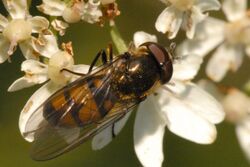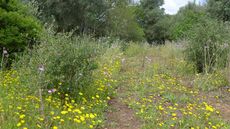Biology:Xanthandrus comtus
| Xanthandrus comtus | |
|---|---|

| |
| Scientific classification | |
| Kingdom: | |
| Phylum: | |
| Class: | |
| Order: | |
| Family: | |
| Genus: | |
| Species: | X. comtus
|
| Binomial name | |
| Xanthandrus comtus (Harris, 1780)[1]
| |
| Synonyms | |
| |
Xanthandrus comtus is a species of hoverfly. It is found in the Palearctic.[2][3]
Description
External images
For terms see Morphology of Diptera
Wing length
Wide abdomen with yellow marks. Thoracic dorsum polished black. Male with round marks on tergite 2 and confluent marks on tergites 3 and 4 (as a deeply incised band). Female with oval marks on tergite 2 and square marks on tergites 3 and 4. legs mainly orange. Antenne orange. Long black pterostigma. The male genitalia and larva are figured by Dusek and Laska (1967).[4]
See references for determination.[5][6][7][8]
Distribution
Palearctic Southern Norway South to Iberia. Ireland East through Central Europe and Southern Europe to Russia and the Caucasus and on to the Russian Far East and the Pacific coast; Japan; Formosa.[9][10]
Biology
Habitat: Fagus, Quercus and Pinus forest and scrub.[11] Flowers visited include umbellifers, Arbutus unedo, Filipendula, Juncus, Leontodon, Lonicera, Mentha aquatica, Rosa, Rubus, Succisa.[12]
The larvae predate aphids and the caterpillars of various small moths including Tortricidae both on trees and low-growing plants. They are also predators of the caterpillars of the pine processionary moths Thaumetopoea pinivora and Thaumetopoea pityocampa.
References
- ↑ 1.0 1.1 Harris, M. (1780). An exposition of English insects. Decads III, IV. London: Robson Co.. pp. 73-99, 100-138, pls. 21-30, 31-40. https://www.biodiversitylibrary.org/item/226006#page/5/mode/1up. Retrieved 16 July 2021.
- ↑ Stubbs, Alan E.; Falk, Steven J (1983). British Hoverflies: An Illustrated Identification Guide (2nd ed.). London: British Entomological and Natural History Society. pp. 253, xvpp. ISBN 1-899935-03-7.
- ↑ Ball, S.G.; Morris, R.K.A. (2000). Provisional atlas of British hoverflies (Diptera, Syrphidae). Monks Wood, UK: Biological Record Centre. pp. 167 pages. ISBN 1-870393-54-6.
- ↑ Dusek, J. & Laska, P. (1967) Versuch zum aufbau eines Naturlichen Systems mitteleuropaischer Arten der Unterfamilie Syrphinae (Diptera). Acta sc.nat.Brno, 1: 349-390.
- ↑ Van Veen, M. (2004) Hoverflies of Northwest Europe: identification keys to the Syrphidae. 256pp. KNNV Publishing, Utrecht.addendum
- ↑ Van der Goot,V.S. (1981) De zweefvliegen van Noordwest - Europa en Europees Rusland, in het bijzonder van de Benelux. KNNV, Uitgave no.32: 275pp. Amsterdam.
- ↑ Bei-Bienko, G.Y. & Steyskal, G.C. (1988) Keys to the Insects of the European Part of the USSR, Volume V: Diptera and Siphonaptera, Part I. Amerind Publishing Co., New Delhi. ISBN:81-205-0080-6.
- ↑ Coe, R.L. (1953) Diptera: Syrphidae. Handbks.ident.Br.insects, 10(1): 1-98. R.ent.Soc.London. pdf
- ↑ Fauna Europaea
- ↑ Peck, L.V. (1988) Syrphidae. In: Soos, A. & Papp, L. (eds.) Catalogue of Palaearctic Diptera, 8: 11-230. Akad.Kiado, Budapest.
- ↑ Speight, M.C.D. (2011). "Species accounts of European Syrphidae (Diptera)". Syrph the Net, the database of European Syrphidae 65: 285pp. http://www.diptera.info/downloads/StN_Species_Accounts_Glasgow_2011.pdf.
- ↑ de Buck, N. (1990) Bloembezoek en bestuivingsecologie van Zweefvliegen (Diptera, Syrphidae) in het bijzonder voor België. Doc.Trav. IRSNB, no.60, 1-167.
Wikidata ☰ Q2746560 entry
 |


